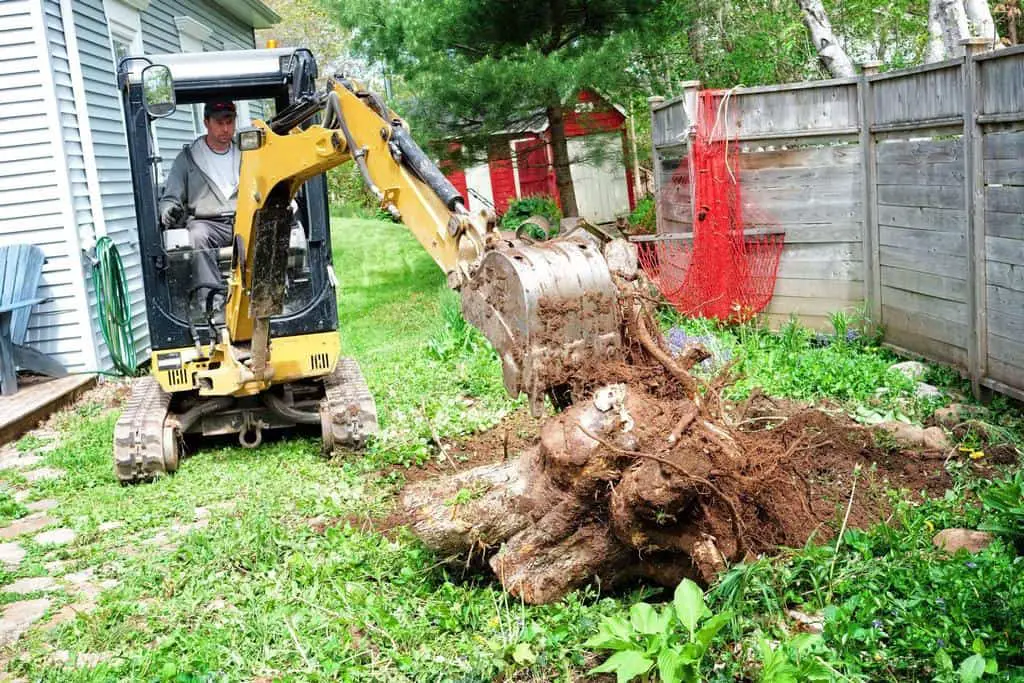Efficient Stump Removal: Choosing the Right Size Excavator for the Job

Welcome to the ultimate guide to efficient stump removal – where we unearth the secrets to bidding farewell to those stubborn remnants of trees that just won’t budge! Let’s face it, tackling stumps can be a daunting task, but fear not, for we have the perfect solution: excavators!
These powerful machines can turn hours of backbreaking labor into a breeze, but here’s the catch – choosing the right size excavator for the job is the key to unlocking unparalleled efficiency.
In this article, we’ll walk you through the art of selecting the ideal excavator size for your stump removal project. From the nimble mini excavators perfect for tight spaces to the mighty giants built to conquer massive stumps, we’ll explore the factors that influence your decision.
So, if you’re ready to excavate your way to stump-free bliss, let’s dive in and discover the magic of finding the perfect fit!
Understanding Stump Removal
At the heart of any tree removal process lies the often overlooked but crucial step of stump removal. Picture it: you’ve just had that overgrown tree trimmed down to size, and it’s no longer dominating your backyard like a giant nature kingpin. But wait! What about that stubborn, protruding stump left behind? That’s where stump removal swoops in to save the day, completing the cycle of tree management.
In essence, stump removal involves getting rid of the remnants of a tree that remain firmly rooted in the ground after the main part of the tree has been cut down. These stumps, if left unattended, can turn into a host of nuisances that plague your property. First and foremost, they can become real obstacles for any future construction or landscaping projects. Imagine trying to build a lovely patio or a charming treehouse with a large, immovable stump standing right in your way.
But the challenges don’t stop there. Those unassuming stumps can become hiding spots for a host of pests, from termites to ants, and can even attract unwanted fungi and diseases. Before you know it, your garden oasis could turn into a pest paradise!
Moreover, from an aesthetic standpoint, these forgotten stumps can drag down the overall appeal of your landscape, undoing all the hard work you’ve put into maintaining a beautiful outdoor space.
By removing these stumps efficiently, you not only open up possibilities for your property’s future but also prevent potential nuisances that might take root—literally! So, the next time you undertake a tree removal project, don’t forget the importance of addressing those stumps as well. Your property will thank you with its newfound potential and unblemished charm.
Importance of Efficient Stump Removal
In the realm of property management, efficient stump removal takes center stage as a crucial task for maintaining a safe and aesthetically pleasing environment. Picture this: You’ve just cut down that old, withering tree that was becoming an eyesore on your property.
Now, you’re left with an unsightly stump, lurking like a forgotten relic amidst your otherwise well-kept landscape. Not only does it spoil the view, but it also poses potential risks to anyone traversing the area. That’s where efficient stump removal comes in to save the day!
Beyond the obvious aesthetic benefits, the removal of tree stumps unlocks a world of possibilities for repurposing your land. Whether you dream of expanding your garden, creating an inviting patio space, or perhaps even constructing a new structure, getting rid of those stumps is the crucial first step. You gain the freedom to redesign your property according to your desires without the hindrance of an immovable wooden obstacle.
Furthermore, safety is a top priority when it comes to managing any property. Hidden tree stumps lurking beneath grass or foliage can be disastrous tripping hazards, especially for children and elderly individuals. Avoiding potential accidents and injuries is essential for providing a secure environment for everyone on your property.
To emphasize the significance of efficient stump removal, let’s take a look at some numbers:
Stump Removal Impact:
| Benefits | Statistics |
| Reduces trip and fall hazards | 78% of landscape injuries are due to tripping and falling. |
| Enhances property aesthetics | 87% of property buyers value a well-maintained landscape. |
| Promotes new plant growth | 90% faster growth rate for new trees planted after stump removal. |
So, don’t underestimate the importance of efficient stump removal. Not only does it clear the way for exciting landscaping projects, but it also ensures the safety and well-being of all those who step foot on your property. Take the leap and bid farewell to those pesky stumps; your property will thank you!
Different Methods of Stump Removal

When it comes to bidding farewell to those pesky stumps, the world of tree management offers an array of techniques to choose from. From old-school manual extraction to modern chemical treatments and fiery burning, each method has its own unique charm. Let’s delve into the different ways you can bid adieu to those stubborn stumps!
- Manual Extraction: Picture a group of determined individuals armed with shovels, pickaxes, and sheer determination. Manual extraction involves digging around the stump and prying it out of the ground bit by bit. While this method may satisfy the purists, it can be labor-intensive and time-consuming, especially for larger stumps with extensive root systems.
- Chemical Treatments: For those who prefer a more hands-off approach, chemical treatments might be the answer. By applying specific stump removal chemicals, you can speed up the decomposition process, making the stump easier to remove. However, this method requires patience, as it can take several weeks or even months for the stump to break down fully.
- Grinding: Enter the stump grinder—a powerful machine that chews through stumps with ease. This method involves grinding the stump into small wood chips, effectively reducing it to ground level or below. Stump grinding is quick, efficient, and leaves you with a landscape ready for a fresh start.
- Burning: For those who don’t mind a touch of fire, burning the stump might be an option. By drilling holes into the stump and filling them with fuel, you can ignite a controlled burn that will slowly consume the stump over time. However, due to the possibility of local fire safety regulations and the fact that this method might not be appropriate for all environments, use it with caution.
The Stand Out Method: Using an Excavator
Among the various techniques, one method stands out as a game-changer: using an excavator. This heavy-duty machine possesses the strength to dig deep and uproot stumps with ease. With its hydraulic power and versatility, an excavator can swiftly remove even the most stubborn stumps, making it an effective and time-saving approach for large-scale stump removal projects.
The Role of Excavators in Stump Removal
Excavators are powerful construction machines with a hydraulic arm, bucket, and cab mounted on a rotating platform. They are designed to handle a wide range of tasks, from land clearing, digging trenches, to demolishing structures. When it comes to stump removal, excavators excel in their ability to uproot stumps and extract them efficiently.
Opting for an excavator for stump removal comes with several benefits. These machines offer superior power and precision, making it easier to remove even large and deeply rooted stumps. Additionally, the operator has excellent control, allowing for careful maneuvering in tight spaces.
Excavators come in various sizes, each catering to specific tasks. For stump removal, mini excavators are ideal for smaller stumps and compact work areas, while larger excavators tackle more massive stumps with ease.
Factors to Consider When Choosing an Excavator
Before diving into the various excavator sizes, let’s first discuss the essential factors to consider when making your choice:
1. Stump Size and Hardness
Stumps come in all shapes and sizes, and some may be tougher to remove than others. Assess the size and hardness of the stumps you’ll be dealing with. Smaller stumps might only require a mini excavator, while larger, more tenacious stumps may demand a larger, more powerful machine.
2. Access and Site Constraints
Consider the access to your stump removal site. If the area is tight and confined, a compact or mini excavator might be the best option to maneuver easily around obstacles. On the other hand, if space isn’t a concern, a larger excavator with a longer reach can offer advantages in terms of efficiency.
3. Budget
Of course, budget plays a crucial role in any project. Excavator rental costs can vary significantly based on size and specifications. Assess your budget and determine what size excavator offers the best balance of performance and affordability.
4. Operator Experience
The proficiency of the operator operating the excavator is another critical consideration. Larger excavators often require more skill and experience to operate safely and effectively. If you have an experienced operator at your disposal, a bigger machine might be a viable option.
5. Environmental Impact
Be mindful of the environmental impact of your stump removal project. Smaller excavators are generally lighter and cause less damage to the surrounding terrain, making them a preferred choice for environmentally sensitive areas.
Understanding Excavator Sizes
Excavators come in various sizes, each designed to cater to different tasks. Let’s explore the different sizes available and the typical applications for each:
1. Mini Excavator
- Weight: 1 to 6 tons
- Typical Bucket Capacity: 0.01 to 0.2 cubic yards
- Best for: Small to medium-sized stumps, tight spaces, and areas with limited accessibility.
Mini excavators are agile and compact, making them ideal for urban environments and residential projects. They offer exceptional maneuverability, allowing operators to work around obstacles easily. If you have small to medium-sized stumps or limited access to your removal site, a mini excavator is a fantastic choice.
2. Compact Excavator
- Weight: 6 to 10 tons
- Typical Bucket Capacity: 0.2 to 0.4 cubic yards
- Best for: Medium-sized stumps and sites with restricted space.
Compact excavators strike a balance between size and power. They are slightly larger than mini excavators, offering increased stability and digging capabilities while still being suitable for sites with limited space. If you have medium-sized stumps and need a bit more power than a mini excavator can provide, a compact excavator should do the job well.
3. Medium Excavator
- Weight: 10 to 45 tons
- Typical Bucket Capacity: 0.4 to 1.0 cubic yards
- Best for: Medium to large-sized stumps and projects with sufficient space.
Medium excavators are the workhorses of stump removal. With increased power and reach, they handle larger stumps with ease. If you have ample space to maneuver and need to tackle sizable stumps, a medium excavator is likely the best fit for your project.
4. Large Excavator
- Weight: 45+ tons
- Typical Bucket Capacity: 1.0+ cubic yards
- Best for: Extra-large stumps and heavy-duty commercial projects.
Large excavators are heavy-duty machines built to handle the most demanding tasks. If you’re dealing with massive stumps or undertaking a commercial-scale stump removal project, a large excavator will provide the power and performance needed to get the job done efficiently.
Selecting the Right Size Excavator
Understanding Different Excavator Sizes: Excavators are classified based on their operating weights. Compact or mini excavators are lightweight and suitable for smaller tasks, while standard or large excavators are more robust and ideal for heavy-duty applications.
Matching Excavator Size to Stump Dimensions: The size of the excavator should be proportionate to the stump’s dimensions and the extent of its root system. Choosing the appropriate size ensures efficient removal without overburdening the machine.
Considering Power and Reach Requirements: Larger stumps or deeply rooted ones may require more power and a longer reach. Evaluate the excavator’s specifications to ensure it can handle the specific demands of the stump removal project.
Taking Accessibility into Account: Evaluate the accessibility of the work site, considering any narrow pathways or obstacles that may hinder the movement of the excavator. Select an excavator that can easily navigate through the available space.
Safety Precautions and Planning
Importance of Safety: Safety should always be a top priority during stump removal operations. Follow industry best practices and take all necessary precautions to protect yourself, the team, and the surrounding property.
Planning the Stump Removal Process: Plan the stump removal process step-by-step to ensure a smooth operation. Consider the order of stumps to be removed and the best approach for each.
Training and Qualifications: Ensure that the excavator operator is properly trained and qualified to handle the machine. Skilled operators can significantly impact the efficiency and safety of the removal process.
Using Appropriate Safety Gear and Equipment: The operator and any personnel involved in the stump removal should wear appropriate safety gear, including helmets, gloves, and eye protection. Additionally, use equipment such as chock blocks and stabilizers to enhance safety.
Preparing the Excavator and Work Site
Before beginning the stump removal process, it’s crucial to ensure that the excavator and work site are ready for action. Here’s what you need to do:
1. Pre-checks and Maintenance for the Excavator: Prior to operating the excavator, conduct thorough pre-checks to ensure everything is in working order. Check the engine, hydraulic systems, and attachments. Performing regular maintenance keeps the machine at its peak performance.
2. Clearing the Work Area: Remove any debris, rocks, or obstacles from the work area that could impede the excavator’s movement. A clean and clutter-free space enhances efficiency and safety during the stump removal process.
3. Securing the Work Site: Safety is paramount during stump removal. Secure the work site by cordoning it off, preventing unauthorized access. Keep onlookers at a safe distance to avoid accidents and maintain a focused work environment.
4. Proper Positioning of the Excavator: Position the excavator strategically, considering factors like the location of the stump, the surrounding landscape, and any potential hazards. A well-placed excavator minimizes unnecessary movements, saving time and effort.
Techniques for Efficient Stump Removal
Efficiency in stump removal is all about employing the right techniques with the excavator. Follow these steps for a seamless removal process:
1. Step-by-Step Process
Begin the removal process by gently breaking the soil around the stump with the excavator’s bucket. Gradually work your way around the stump to expose its roots. This step-by-step approach ensures controlled removal and prevents sudden movements that may cause damage.
2. Utilizing the Excavator’s Features
Modern excavators come equipped with a variety of features that enhance efficiency. Utilize the hydraulic arm’s precision and power to navigate around complex root systems and extract the stump with ease.
3. Minimizing Damage to the Surrounding Landscape
Carefully extract the stump while minimizing disruption to the surrounding landscape. Avoid unnecessary impacts on nearby plants, shrubs, or structures to maintain the site’s aesthetic appeal.
4. Dealing with Challenging Stumps and Root Systems
Some stumps may pose more challenges than others, especially if they have extensive root systems. Be patient and use the excavator’s power to loosen the roots gradually, ensuring a complete removal.
Post-Removal Site Restoration
Removing a stump leaves behind a void that requires attention and restoration:
1. Addressing the Void: Once the stump is removed, assess the void left in its place. Plan how you will fill it, considering the site’s aesthetics and future use.
2. Replanting or Regrading: Replanting a new tree or regrading the area ensures that the landscape remains harmonious and stable.
3. Restoring the Site: Return the site to its previous condition or better. Proper restoration ensures that the stump removal process enhances the overall appeal of the property.
4. Preventing Potential Issues: Take preventative measures to avoid issues like erosion or settling. Proper restoration helps maintain a stable and safe environment.
Cost Analysis and Budgeting
The cost of stump removal with an excavator can vary based on multiple factors:
1. Factors Affecting the Cost: Consider the size and number of stumps, their accessibility, and the complexity of their root systems. These factors influence the overall cost of the stump removal project.
2. Obtaining and Comparing Quotes: Reach out to different service providers for quotes. Compare their offerings, including equipment, expertise, and additional services.
3. Budgeting for Additional Expenses: Be prepared for unexpected expenses that may arise during the stump removal process. Having a contingency budget ensures a smooth operation.
4. Considering Long-Term Benefits: While the initial cost of stump removal may seem significant, consider the long-term benefits, including improved aesthetics, safety, and potential savings from avoiding future hazards.
Conclusion
In conclusion, efficient stump removal through the use of the right-sized excavator is a transformative process that enhances your property’s safety and appeal. By preparing the excavator and work site, employing the right techniques, being environmentally conscious, and planning for site restoration and budgeting, you can ensure a successful and satisfying stump removal experience.
With a well-executed plan, you’ll bid farewell to those stubborn stumps and welcome a fresh start for your landscape. Happy stump removal!
FAQs on Choosing the Right Size Excavator for Stump Removal
What is the cost of stump removal with an excavator?
What is the cost of stump removal with an excavator?
Can I remove a stump myself with an excavator?
Removing a stump with an excavator requires proper knowledge and experience in operating the machine. While it’s possible for experienced individuals, it’s recommended to hire a professional to ensure safe and efficient removal.
Can I remove stumps with a bulldozer?
While it is possible to remove a stump with a bulldozer, there are some considerations to keep in mind. It’s important to note that removing a stump with a bulldozer can be a challenging task and may require some experience operating heavy machinery.
How deep can an excavator remove a stump?
An excavator can typically remove a stump to a depth of around 12 to 24 inches below ground level, depending on the size and type of the stump.
How long does it take to remove a stump with an excavator?
The time it takes to remove a stump with an excavator depends on the size and hardness of the stump, the type of soil, and the skill of the operator. Generally, it can take anywhere from 15 minutes to an hour per stump.
Are there any regulations or permits needed for stump removal using an excavator?
Regulations and permits for stump removal with an excavator may vary depending on your location and local ordinances. It’s essential to check with your local authorities to determine if any permits are required.
Can I use a small excavator for large stump removal?
While a small excavator can handle small to medium-sized stumps, using it for large stump removal might not be efficient. Larger stumps often require more power and reach, better suited to medium or large excavators.
Are there any specific excavator attachments designed for stump removal?
Yes, there are specific excavator attachments designed for stump removal. Stump grinder attachments are commonly used to grind stumps into mulch, making the removal process more efficient.
What type of excavator is best for removing stumps in tight spaces?
Mini excavators are best for removing stumps in tight spaces. Their compact size and maneuverability allow them to work effectively in confined areas, such as residential yards.
Can an excavator remove stumps in sensitive or hard-to-reach areas?
Yes, an excavator can be used to remove stumps in sensitive or hard-to-reach areas. Their versatility and precision make them suitable for carefully navigating challenging terrain and preserving the surrounding environment.






